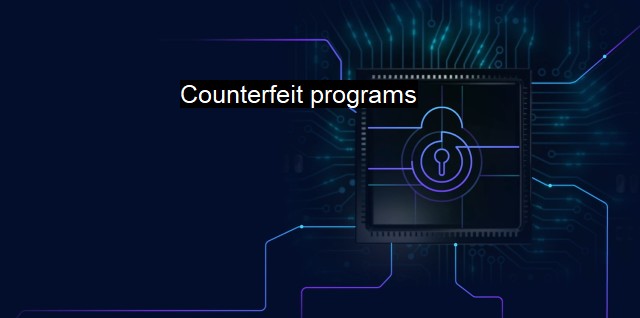What are Counterfeit programs?
The Danger of Counterfeit Programs: A Cybersecurity Perspective
Counterfeit programs are unauthorized replicas of licensed software. These fraudulent duplications also known as pirated software, are made with the intention of maliciously deceiving and exploiting the unaware users for various sinister purposes including but not limited to stealing personal information, facilitating unauthorized access to systems or networks, malware distribution, and causing financial loss to the original software creators.Counterfeit programs bear a striking resemblance to the original software to fool individuals and businesses into installing them. Once integrated in a system, they can cause severe damage not only by functioning differently from authentic software by introducing errors and inconsistent results, but also by deploying malicious software and viruses that make systems susceptible to external threats.
Often appearing legitimate and well-designed, counterfeit programs may offer the same suite of functionalities as the original software and sometimes even include forged certificates of authenticity, to convince potential victims of their genuineness. In fact, the deceptive facades of these programs frequently mirror the visual interface of the real software so accurately that victims do not even realize they have been tricked into installing a counterfeit version.
The commercial market is a significant breeding ground for counterfeit programs. popular software like Microsoft Office, Photoshop, and antivirus solutions such as Norton or McAfee are often targeted due to their widespread use. The lucrative appeal of getting premium software for free or at a significantly reduced price is what makes people, especially those who are not aware of the perturbing consequences of employing counterfeit programs, fall into the trap.
Criminals relish the attraction of counterfeit programs because they offer an efficient and low-risk vehicle for them to proliferate malicious tools such as trojans, ransomware, spyware, and other forms of malware. For instance, the counterfeit version could be embedded into unsuspecting victims' devices clandestinely where it will constantly monitor and collect personal data like banking details, email correspondence, and passwords.
In an organizational context, the risks become even more profound as counterfeits can trigger security breaches, data thefts, and system failures, all of which can severely impact business continuity and lead to substantial financial and reputational damage. Security systems can be compromised, making it easier for hackers to gain unauthorized access to sensitive data.
Counterfeit programs also pose a significant threat to personal and communal cybersecurity, as they increasingly facilitate the spread of botnets-- networks of infected devices used to perpetrate further cyberattacks or disseminate more counterfeit programs. Also, software makers lose significant revenue due to these counterfeits, leading to a decrease in the inflow of funds for the research and development of new software.
On the preventive side, consumers and enterprises are strongly urged to download and install software only from licensed and trusted sources. Also, the need for robust and updated antivirus and antimalware solutions to safeguard against potential threats should be underlined.
While dealing with software vendors, users must also conduct careful scrutiny if they're not directly dealing with the software company itself. Measures such as investigating the reputation of vendors, assessing the authenticity of certificates, and verifying the security credentials of the software can be helpful.
Counterfeit programs are significant threats to small and large-scale users alike in today's ever-evolving cyberspace. They not only weaken the susceptible points in a cybersecurity framework but also undermine the bedrocks of software creativity and economic sustainability.

Counterfeit programs FAQs
What are counterfeit programs?
Counterfeit programs are software that appears to be legitimate but is actually a fake or imitated version of an authentic program. These programs are created and distributed with the intention of deceiving users and often contain malicious code that can harm a user's computer, steal personal information, or compromise their cybersecurity.How can I identify counterfeit programs?
One way to identify counterfeit programs is by checking the software's source. Always download software from reputable sources and avoid downloading from unfamiliar websites or links. Additionally, keep an eye out for fake pop-up ads or alerts that claim your computer is infected with a virus and prompt you to download a program.What are the risks of using counterfeit programs?
Using counterfeit programs can put your computer and personal information at risk. These programs may contain malware, viruses, or other harmful code that can damage your system, steal your data, or give hackers access to your device. Additionally, counterfeit programs may not be updated regularly, leaving your computer vulnerable to known security threats.How can I protect myself from counterfeit programs?
To protect yourself from counterfeit programs, it's important to have reputable antivirus software installed on your computer. This software can detect and remove malicious software and prevent counterfeit programs from being installed. Additionally, avoid downloading software from unfamiliar sources, and always keep your operating system and software up-to-date with the latest security patches. Finally, use caution when clicking on links or downloading software, and always verify the authenticity of a program before installing it.| | A | | | B | | | C | | | D | | | E | | | F | | | G | | | H | | | I | | | J | | | K | | | L | | | M | |
| | N | | | O | | | P | | | Q | | | R | | | S | | | T | | | U | | | V | | | W | | | X | | | Y | | | Z | |
| | 1 | | | 2 | | | 3 | | | 4 | | | 7 | | | 8 | | |||||||